Biology:Steroid
A steroid is a biologically active organic compound with four rings arranged in a specific molecular configuration. Steroids have two principal biological functions: as important components of cell membranes that alter membrane fluidity; and as signaling molecules. Hundreds of steroids are found in plants, animals and fungi. All steroids are manufactured in cells from the sterols lanosterol (opisthokonts) or cycloartenol (plants). Lanosterol and cycloartenol are derived from the cyclization of the triterpene squalene.[1]
The steroid core structure is typically composed of seventeen carbon atoms, bonded in four "fused" rings: three six-member cyclohexane rings (rings A, B and C in the first illustration) and one five-member cyclopentane ring (the D ring). Steroids vary by the functional groups attached to this four-ring core and by the oxidation state of the rings. Sterols are forms of steroids with a hydroxy group at position three and a skeleton derived from cholestane.[2]:1785f[3] Steroids can also be more radically modified, such as by changes to the ring structure, for example, cutting one of the rings. Cutting Ring B produces secosteroids one of which is vitamin D3.
Examples include anabolic steroids, the lipid cholesterol, the sex hormones estradiol and testosterone,[4]:10–19 and the anti-inflammatory drug dexamethasone.[5]
Nomenclature
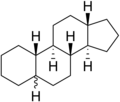

Gonane, also known as steran or cyclopentanoperhydrophenanthrene, the simplest steroid and the nucleus of all steroids and sterols,[6][7] is composed of seventeen carbon atoms in carbon-carbon bonds forming four fused rings in a three-dimensional shape. The three cyclohexane rings (A, B, and C in the first illustration) form the skeleton of a perhydro derivative of phenanthrene. The D ring has a cyclopentane structure. When the two methyl groups and eight carbon side chains (at C-17, as shown for cholesterol) are present, the steroid is said to have a cholestane framework. The two common 5α and 5β stereoisomeric forms of steroids exist because of differences in the side of the largely planar ring system where the hydrogen (H) atom at carbon-5 is attached, which results in a change in steroid A-ring conformation. Isomerisation at the C-21 side chain produces a parallel series of compounds, referred to as isosteroids.[8]
Examples of steroid structures are:
-
Dexamethasone, a synthetic corticosteroid drug
-
Lanosterol, the biosynthetic precursor to animal steroids. The number of carbons (30) indicates its triterpenoid classification.
-
Progesterone, a steroid hormone involved in the female menstrual cycle, pregnancy, and embryogenesis
-
Medrogestone, a synthetic drug with effects similar to progesterone
-
β-Sitosterol, a plant or phytosterol, with a fully branched hydrocarbon side chain at C-17 and an hydroxyl group at C-3
In addition to the ring scissions (cleavages), expansions and contractions (cleavage and reclosing to a larger or smaller rings)—all variations in the carbon-carbon bond framework—steroids can also vary:
- in the bond orders within the rings,
- in the number of methyl groups attached to the ring (and, when present, on the prominent side chain at C17),
- in the functional groups attached to the rings and side chain, and
- in the configuration of groups attached to the rings and chain.[4]:2–9
For instance, sterols such as cholesterol and lanosterol have a hydroxyl group attached at position C-3, while testosterone and progesterone have a carbonyl (oxo substituent) at C-3; of these, lanosterol alone has two methyl groups at C-4 and cholesterol (with a C-5 to C-6 double bond) differs from testosterone and progesterone (which have a C-4 to C-5 double bond).
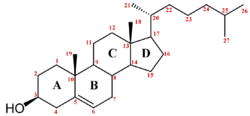 |
 |
Species distribution and function
In eukaryotes, steroids are found in fungi, animals, and plants.
Fungal steroids
Fungal steroids include the ergosterols, which are involved in maintaining the integrity of the fungal cellular membrane. Various antifungal drugs, such as amphotericin B and azole antifungals, utilize this information to kill pathogenic fungi.[9] Fungi can alter their ergosterol content (e.g. through loss of function mutations in the enzymes ERG3 or ERG6, inducing depletion of ergosterol, or mutations that decrease the ergosterol content) to develop resistance to drugs that target ergosterol.[10]
Ergosterol is analogous to the cholesterol found in the cellular membranes of animals (including humans), or the phytosterols found in the cellular membranes of plants.[10] All mushrooms contain large quantities of ergosterol, in the range of tens to hundreds of milligrams per 100 grams of dry weight.[10] Oxygen is necessary for the synthesis of ergosterol in fungi.[10]
Ergosterol is responsible for the vitamin D content found in mushrooms; ergosterol is chemically converted into provitamin D2 by exposure to ultraviolet light.[10] Provitamin D2 spontaneously forms vitamin D2.[10] However, not all fungi utilize ergosterol in their cellular membranes; for example, the pathogenic fungal species Pneumocystis jirovecii does not, which has important clinical implications (given the mechanism of action of many antifungal drugs). Using the fungus Saccharomyces cerevisiae as an example, other major steroids include ergosta‐5,7,22,24(28)‐tetraen‐3β‐ol, zymosterol, and lanosterol. S. cerevisiae utilizes 5,6‐dihydroergosterol in place of ergosterol in its cell membrane.[10]
Animal steroids
Animal steroids include compounds of vertebrate and insect origin, the latter including ecdysteroids such as ecdysterone (controlling molting in some species). Vertebrate examples include the steroid hormones and cholesterol; the latter is a structural component of cell membranes that helps determine the fluidity of cell membranes and is a principal constituent of plaque (implicated in atherosclerosis). Steroid hormones include:
- Sex hormones, which influence sex differences and support reproduction. These include androgens, estrogens, and progestogens.
- Corticosteroids, including most synthetic steroid drugs, with natural product classes the glucocorticoids (which regulate many aspects of metabolism and immune function) and the mineralocorticoids (which help maintain blood volume and control renal excretion of electrolytes)
- Anabolic steroids, natural and synthetic, which interact with androgen receptors to increase muscle and bone synthesis. In popular use, the term "steroids" often refers to anabolic steroids.
Plant steroids
Plant steroids include steroidal alkaloids found in Solanaceae[11] and Melanthiaceae (specially the genus Veratrum),[12] cardiac glycosides,[13] the phytosterols and the brassinosteroids (which include several plant hormones).
Prokaryotes
This section is missing information about non-eukaryotic type sterol framework – see PMID 27446030, fig 4/5, group 1 oxidosqualene cyclase. (November 2021) |
In prokaryotes, biosynthetic pathways exist for the tetracyclic steroid framework (e.g. in mycobacteria)[14] – where its origin from eukaryotes is conjectured[15] – and the more-common pentacyclic triterpinoid hopanoid framework.[16]
Types
By function
- Corticosteroids:
- Glucocorticoids:
- Cortisol, a glucocorticoid whose functions include immunosuppression
- Mineralocorticoids:
- Aldosterone, a mineralocorticoid that helps regulate blood pressure through water and electrolyte balance
- Glucocorticoids:
- Sex steroids:
- Progestogens:
- Progesterone, which regulates cyclical changes in the endometrium of the uterus and maintains a pregnancy
- Androgens:
- Testosterone, which contributes to the development and maintenance of male secondary sex characteristics
- Estrogens:
- Estradiol, which contributes to the development and maintenance of female secondary sex characteristics
- Progestogens:
Additional classes of steroids include:
- Neurosteroids such as DHEA and allopregnanolone
- Bile acids such as taurocholic acid
- Aminosteroid neuromuscular blocking agents (mainly synthetic) such as pancuronium bromide
- Steroidal antiandrogens (mainly synthetic) such as cyproterone acetate
- Steroidogenesis inhibitors (mainly exogenous) such as alfatradiol
- Membrane sterols such as cholesterol, ergosterol, and various phytosterols
- Toxins such as steroidal saponins and cardenolides/cardiac glycosides
As well as the following class of secosteroids (open-ring steroids):
- Vitamin D forms such as ergocalciferol, cholecalciferol, and calcitriol
By structure
Intact ring system
Steroids can be classified based on their chemical composition.[17] One example of how MeSH performs this classification is available at the Wikipedia MeSH catalog. Examples of this classification include:
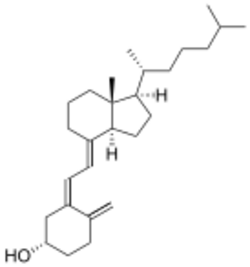

| Class | Example | Number of carbon atoms |
|---|---|---|
| Cholestanes | Cholesterol | 27 |
| Cholanes | Cholic acid | 24 |
| Pregnanes | Progesterone | 21 |
| Androstanes | Testosterone | 19 |
| Estranes | Estradiol | 18 |
In biology, it is common to name the above steroid classes by the number of carbon atoms present when referring to hormones: C18-steroids for the estranes (mostly estrogens), C19-steroids for the androstanes (mostly androgens), and C21-steroids for the pregnanes (mostly corticosteroids).[18] The classification "17-ketosteroid" is also important in medicine.
The gonane (steroid nucleus) is the parent 17-carbon tetracyclic hydrocarbon molecule with no alkyl sidechains.[19]
Cleaved, contracted, and expanded rings
Secosteroids (Latin seco, "to cut") are a subclass of steroidal compounds resulting, biosynthetically or conceptually, from scission (cleavage) of parent steroid rings (generally one of the four). Major secosteroid subclasses are defined by the steroid carbon atoms where this scission has taken place. For instance, the prototypical secosteroid cholecalciferol, vitamin D3 (shown), is in the 9,10-secosteroid subclass and derives from the cleavage of carbon atoms C-9 and C-10 of the steroid B-ring; 5,6-secosteroids and 13,14-steroids are similar.[20]
Norsteroids (nor-, L. norma; "normal" in chemistry, indicating carbon removal)[21] and homosteroids (homo-, Greek homos; "same", indicating carbon addition) are structural subclasses of steroids formed from biosynthetic steps. The former involves enzymic ring expansion-contraction reactions, and the latter is accomplished (biomimetically) or (more frequently) through ring closures of acyclic precursors with more (or fewer) ring atoms than the parent steroid framework.[22]
Combinations of these ring alterations are known in nature. For instance, ewes who graze on corn lily ingest cyclopamine (shown) and veratramine, two of a sub-family of steroids where the C- and D-rings are contracted and expanded respectively via a biosynthetic migration of the original C-13 atom. Ingestion of these C-nor-D-homosteroids results in birth defects in lambs: cyclopia from cyclopamine and leg deformity from veratramine.[23] A further C-nor-D-homosteroid (nakiterpiosin) is excreted by Okinawan cyanobacteriosponges. e.g., Terpios hoshinota, leading to coral mortality from black coral disease.[24] Nakiterpiosin-type steroids are active against the signaling pathway involving the smoothened and hedgehog proteins, a pathway which is hyperactive in a number of cancers.
Biological significance
Steroids and their metabolites often function as signalling molecules (the most notable examples are steroid hormones), and steroids and phospholipids are components of cell membranes.[25] Steroids such as cholesterol decrease membrane fluidity.[26] Similar to lipids, steroids are highly concentrated energy stores. However, they are not typically sources of energy; in mammals, they are normally metabolized and excreted.
Steroids play critical roles in a number of disorders, including malignancies like prostate cancer, where steroid production inside and outside the tumour promotes cancer cell aggressiveness.[27]
Biosynthesis and metabolism

The hundreds of steroids found in animals, fungi, and plants are made from lanosterol (in animals and fungi; see examples above) or cycloartenol (in other eukaryotes). Both lanosterol and cycloartenol derive from cyclization of the triterpenoid squalene.[1] Lanosterol and cycloartenol are sometimes called protosterols because they serve as the starting compounds for all other steroids.
Steroid biosynthesis is an anabolic pathway which produces steroids from simple precursors. A unique biosynthetic pathway is followed in animals (compared to many other organisms), making the pathway a common target for antibiotics and other anti-infection drugs. Steroid metabolism in humans is also the target of cholesterol-lowering drugs, such as statins. In humans and other animals the biosynthesis of steroids follows the mevalonate pathway, which uses acetyl-CoA as building blocks for dimethylallyl diphosphate (DMAPP) and isopentenyl diphosphate (IPP).[28] In subsequent steps DMAPP and IPP conjugate to form farnesyl diphosphate (FPP), which further conjugates with each other to form the linear triterpenoid squalene. Squalene biosynthesis is catalyzed by squalene synthase, which belongs to the squalene/phytoene synthase family. Subsequent epoxidation and cyclization of squalene generate lanosterol, which is the starting point for additional modifications into other steroids (steroidogenesis).[29] In other eukaryotes, the cyclization product of epoxidized squalene (oxidosqualene) is cycloartenol.
Mevalonate pathway
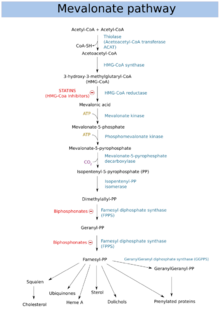
The mevalonate pathway (also called HMG-CoA reductase pathway) begins with acetyl-CoA and ends with dimethylallyl diphosphate (DMAPP) and isopentenyl diphosphate (IPP).
DMAPP and IPP donate isoprene units, which are assembled and modified to form terpenes and isoprenoids[30] (a large class of lipids, which include the carotenoids and form the largest class of plant natural products.[31] Here, the isoprene units are joined to make squalene and folded into a set of rings to make lanosterol.[32] Lanosterol can then be converted into other steroids, such as cholesterol and ergosterol.[32][33]
Two classes of drugs target the mevalonate pathway: statins (like rosuvastatin), which are used to reduce elevated cholesterol levels,[34] and bisphosphonates (like zoledronate), which are used to treat a number of bone-degenerative diseases.[35]
Steroidogenesis
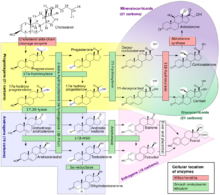
Steroidogenesis is the biological process by which steroids are generated from cholesterol and changed into other steroids.[37] The pathways of steroidogenesis differ among species. The major classes of steroid hormones, as noted above (with their prominent members and functions), are the progestogens, corticosteroids (corticoids), androgens, and estrogens.[38] Human steroidogenesis of these classes occurs in a number of locations:
- Progestogens are the precursors of all other human steroids, and all human tissues which produce steroids must first convert cholesterol to pregnenolone. This conversion is the rate-limiting step of steroid synthesis, which occurs inside the mitochondrion of the respective tissue.[39][38] *Cortisol, corticosterone, aldosterone, and testosterone are produced in the adrenal cortex.[38]
- Stromal cells have been shown to produce steroids in response to signaling produced by androgen-starved prostate cancer cells.[40][non-primary source needed]
| Sex | Sex hormone | Reproductive phase |
Blood production rate |
Gonadal secretion rate |
Metabolic clearance rate |
Reference range (serum levels) | |
|---|---|---|---|---|---|---|---|
| SI units | Non-SI units | ||||||
| Men | Androstenedione | –
|
2.8 mg/day | 1.6 mg/day | 2200 L/day | 2.8–7.3 nmol/L | 80–210 ng/dL |
| Testosterone | –
|
6.5 mg/day | 6.2 mg/day | 950 L/day | 6.9–34.7 nmol/L | 200–1000 ng/dL | |
| Estrone | –
|
150 μg/day | 110 μg/day | 2050 L/day | 37–250 pmol/L | 10–70 pg/mL | |
| Estradiol | –
|
60 μg/day | 50 μg/day | 1600 L/day | <37–210 pmol/L | 10–57 pg/mL | |
| Estrone sulfate | –
|
80 μg/day | Insignificant | 167 L/day | 600–2500 pmol/L | 200–900 pg/mL | |
| Women | Androstenedione | –
|
3.2 mg/day | 2.8 mg/day | 2000 L/day | 3.1–12.2 nmol/L | 89–350 ng/dL |
| Testosterone | –
|
190 μg/day | 60 μg/day | 500 L/day | 0.7–2.8 nmol/L | 20–81 ng/dL | |
| Estrone | Follicular phase | 110 μg/day | 80 μg/day | 2200 L/day | 110–400 pmol/L | 30–110 pg/mL | |
| Luteal phase | 260 μg/day | 150 μg/day | 2200 L/day | 310–660 pmol/L | 80–180 pg/mL | ||
| Postmenopause | 40 μg/day | Insignificant | 1610 L/day | 22–230 pmol/L | 6–60 pg/mL | ||
| Estradiol | Follicular phase | 90 μg/day | 80 μg/day | 1200 L/day | <37–360 pmol/L | 10–98 pg/mL | |
| Luteal phase | 250 μg/day | 240 μg/day | 1200 L/day | 699–1250 pmol/L | 190–341 pg/mL | ||
| Postmenopause | 6 μg/day | Insignificant | 910 L/day | <37–140 pmol/L | 10–38 pg/mL | ||
| Estrone sulfate | Follicular phase | 100 μg/day | Insignificant | 146 L/day | 700–3600 pmol/L | 250–1300 pg/mL | |
| Luteal phase | 180 μg/day | Insignificant | 146 L/day | 1100–7300 pmol/L | 400–2600 pg/mL | ||
| Progesterone | Follicular phase | 2 mg/day | 1.7 mg/day | 2100 L/day | 0.3–3 nmol/L | 0.1–0.9 ng/mL | |
| Luteal phase | 25 mg/day | 24 mg/day | 2100 L/day | 19–45 nmol/L | 6–14 ng/mL | ||
Notes and sources
Notes: "The concentration of a steroid in the circulation is determined by the rate at which it is secreted from glands, the rate of metabolism of precursor or prehormones into the steroid, and the rate at which it is extracted by tissues and metabolized. The secretion rate of a steroid refers to the total secretion of the compound from a gland per unit time. Secretion rates have been assessed by sampling the venous effluent from a gland over time and subtracting out the arterial and peripheral venous hormone concentration. The metabolic clearance rate of a steroid is defined as the volume of blood that has been completely cleared of the hormone per unit time. The production rate of a steroid hormone refers to entry into the blood of the compound from all possible sources, including secretion from glands and conversion of prohormones into the steroid of interest. At steady state, the amount of hormone entering the blood from all sources will be equal to the rate at which it is being cleared (metabolic clearance rate) multiplied by blood concentration (production rate = metabolic clearance rate × concentration). If there is little contribution of prohormone metabolism to the circulating pool of steroid, then the production rate will approximate the secretion rate." Sources: See template. | |||||||
Alternative pathways
In plants and bacteria, the non-mevalonate pathway (MEP pathway) uses pyruvate and glyceraldehyde 3-phosphate as substrates to produce IPP and DMAPP.[30][41]
During diseases pathways otherwise not significant in healthy humans can become utilized. For example, in one form of congenital adrenal hyperplasia a deficiency in the 21-hydroxylase enzymatic pathway leads to an excess of 17α-Hydroxyprogesterone (17-OHP) – this pathological excess of 17-OHP in turn may be converted to dihydrotestosterone (DHT, a potent androgen) through among others 17,20 Lyase (a member of the cytochrome P450 family of enzymes), 5α-Reductase and 3α-Hydroxysteroid dehydrogenase.[42]
Catabolism and excretion
Steroids are primarily oxidized by cytochrome P450 oxidase enzymes, such as CYP3A4. These reactions introduce oxygen into the steroid ring, allowing the cholesterol to be broken up by other enzymes into bile acids.[43] These acids can then be eliminated by secretion from the liver in bile.[44] The expression of the oxidase gene can be upregulated by the steroid sensor PXR when there is a high blood concentration of steroids.[45] Steroid hormones, lacking the side chain of cholesterol and bile acids, are typically hydroxylated at various ring positions or oxidized at the 17 position, conjugated with sulfate or glucuronic acid and excreted in the urine.[46]
Isolation, structure determination, and methods of analysis
Steroid isolation, depending on context, is the isolation of chemical matter required for chemical structure elucidation, derivitzation or degradation chemistry, biological testing, and other research needs (generally milligrams to grams, but often more[47] or the isolation of "analytical quantities" of the substance of interest (where the focus is on identifying and quantifying the substance (for example, in biological tissue or fluid). The amount isolated depends on the analytical method, but is generally less than one microgram.[48] The methods of isolation to achieve the two scales of product are distinct, but include extraction, precipitation, adsorption, chromatography, and crystallization. In both cases, the isolated substance is purified to chemical homogeneity; combined separation and analytical methods, such as LC-MS, are chosen to be "orthogonal"—achieving their separations based on distinct modes of interaction between substance and isolating matrix—to detect a single species in the pure sample.
Structure determination refers to the methods to determine the chemical structure of an isolated pure steroid, using an evolving array of chemical and physical methods which have included NMR and small-molecule crystallography.[4]:10–19 Methods of analysis overlap both of the above areas, emphasizing analytical methods to determining if a steroid is present in a mixture and determining its quantity.[48]
Chemical synthesis
Microbial catabolism of phytosterol side chains yields C-19 steroids, C-22 steroids, and 17-ketosteroids (i.e. precursors to adrenocortical hormones and contraceptives).[49][50][51] The addition and modification of functional groups is key when producing the wide variety of medications available within this chemical classification. These modifications are performed using conventional organic synthesis and/or biotransformation techniques.[52][53]
Precursors
Semisynthesis
The semisynthesis of steroids often begins from precursors such as cholesterol,[51] phytosterols,[50] or sapogenins.[54] The efforts of Syntex, a company involved in the Mexican barbasco trade, used Dioscorea mexicana to produce the sapogenin diosgenin in the early days of the synthetic steroid pharmaceutical industry.[47]
Total synthesis
Some steroidal hormones are economically obtained only by total synthesis from petrochemicals (e.g. 13-alkyl steroids).[51] For example, the pharmaceutical Norgestrel begins from methoxy-1-tetralone, a petrochemical derived from phenol.
Research awards
A number of Nobel Prizes have been awarded for steroid research, including:
- 1927 (Chemistry) Heinrich Otto Wieland — Constitution of bile acids and sterols and their connection to vitamins[55]
- 1928 (Chemistry) Adolf Otto Reinhold Windaus — Constitution of sterols and their connection to vitamins[56]
- 1939 (Chemistry) Adolf Butenandt and Leopold Ružička — Isolation and structural studies of steroid sex hormones, and related studies on higher terpenes[57]
- 1950 (Physiology or Medicine) Edward Calvin Kendall, Tadeus Reichstein, and Philip Hench — Structure and biological effects of adrenal hormones[58]
- 1965 (Chemistry) Robert Burns Woodward — In part, for the synthesis of cholesterol, cortisone, and lanosterol[59]
- 1969 (Chemistry) Derek Barton and Odd Hassel — Development of the concept of conformation in chemistry, emphasizing the steroid nucleus[60]
- 1975 (Chemistry) Vladimir Prelog — In part, for developing methods to determine the stereochemical course of cholesterol biosynthesis from mevalonic acid via squalene[61]
See also
- Adrenal gland
- Batrachotoxin
- List of steroid abbreviations
- List of steroids
- Membrane steroid receptor
- Pheromone
- Reverse cholesterol transport
- Steroidogenesis inhibitor
- Steroidogenic acute regulatory protein
- Steroidogenic enzyme
References
- ↑ 1.0 1.1 "Lanosterol biosynthesis". Recommendations on Biochemical & Organic Nomenclature, Symbols & Terminology. International Union Of Biochemistry And Molecular Biology. http://www.chem.qmul.ac.uk/iubmb/enzyme/reaction/terp/lanost.html.
- ↑ 2.0 2.1 2.2 "Nomenclature of steroids, recommendations 1989". Pure Appl. Chem. 61 (10): 1783–1822. 1989. doi:10.1351/pac198961101783. http://iupac.org/publications/pac/pdf/1989/pdf/6110x1783.pdf. Also available with the same authors at "IUPAC-IUB Joint Commission on Biochemical Nomenclature (JCBN). The nomenclature of steroids. Recommendations 1989". European Journal of Biochemistry 186 (3): 429–58. Dec 1989. doi:10.1111/j.1432-1033.1989.tb15228.x. PMID 2606099.; Also available online at "The Nomenclature of Steroids". London, GBR: Queen Mary University of London. p. 3S–1.4. http://www.chem.qmul.ac.uk/iupac/steroid/3S01.html.
- ↑ Also available in print at Dictionary of Steroids. London, GBR: Chapman and Hall. 1991. pp. xxx–lix. ISBN 978-0412270604. https://books.google.com/books?isbn=0412270609. Retrieved 20 June 2015.
- ↑ 4.0 4.1 4.2 Steroid Chemistry at a Glance. Hoboken: Wiley. 2011. ISBN 978-0-470-66084-3.
- ↑ "Antiinflammatory action of glucocorticoids--new mechanisms for old drugs". The New England Journal of Medicine 353 (16): 1711–23. Oct 2005. doi:10.1056/NEJMra050541. PMID 16236742. https://pedclerk.uchicago.edu/sites/pedclerk.uchicago.edu/files/uploads/Addison'sGCTx.NEJM_.2005.pdf.
- ↑ Victor A. Rogozkin (14 June 1991). Metabolism of Anabolic-Androgenic Steroids. CRC Press. pp. 1–. ISBN 978-0-8493-6415-0. https://books.google.com/books?id=hRsnmJRF1WgC&pg=PA1. "The steroid structural base is a steran nucleus, a polycyclic C17 steran skeleton consisting of three condensed cyclohexane rings in nonlinear or phenanthrene junction (A, B, and C), and a cyclopentane ring (D).1,2"
- ↑ Klaus Urich (16 September 1994). Comparative Animal Biochemistry. Springer Science & Business Media. pp. 624–. ISBN 978-3-540-57420-0. https://books.google.com/books?id=GLbcWyeaCGQC&pg=PA624.
- ↑ Greep 2013.
- ↑ "Human Fungal Pathogens and Drug Resistance Against Azole Drugs" (in en). Drug Resistance in Bacteria, Fungi, Malaria, and Cancer. Springer. 2017-03-21. ISBN 978-3-319-48683-3.
- ↑ 10.0 10.1 10.2 10.3 10.4 10.5 10.6 (in en) Fungi: Biology and Applications. John Wiley & Sons, Inc.. 8 September 2017. ISBN 9781119374312.
- ↑ "Evolution of secondary metabolites from an ecological and molecular phylogenetic perspective". Phytochemistry 64 (1): 3–19. Sep 2003. doi:10.1016/S0031-9422(03)00300-5. PMID 12946402.
- ↑ Mind-altering and poisonous plants of the world. Portland (Oregon USA) and Salusbury (London England): Timber press inc.. 2008. pp. 252, 253 and 254. ISBN 978-0-88192-952-2.
- ↑ Mind-altering and poisonous plants of the world. Portland (Oregon USA) and Salusbury (London England): Timber press inc.. 2008. pp. 324, 325 and 326. ISBN 978-0-88192-952-2.
- ↑ "Steroid biosynthesis in prokaryotes: identification of myxobacterial steroids and cloning of the first bacterial 2,3(S)-oxidosqualene cyclase from the myxobacterium Stigmatella aurantiaca". Molecular Microbiology 47 (2): 471–81. Jan 2003. doi:10.1046/j.1365-2958.2003.03309.x. PMID 12519197.
- ↑ "Phylogenomics of sterol synthesis: insights into the origin, evolution, and diversity of a key eukaryotic feature". Genome Biology and Evolution 1: 364–81. 2009. doi:10.1093/gbe/evp036. PMID 20333205.
- ↑ "Squalene-hopene cyclases". Applied and Environmental Microbiology 77 (12): 3905–15. Jun 2011. doi:10.1128/AEM.00300-11. PMID 21531832. Bibcode: 2011ApEnM..77.3905S.
- ↑ Steroids (Health and Medical Issues Today). Westport, CT: Greenwood Press. 2014. pp. 10–12. ISBN 978-1440802997.
- ↑ "C19-steroid hormone biosynthetic pathway - Ontology Browser - Rat Genome Database". https://rgd.mcw.edu/rgdweb/ontology/view.html?acc_id=PW:0000770.
- ↑ "Nomenclature of the gonane progestins". Contraception 60 (6): 313. Dec 1999. doi:10.1016/S0010-7824(99)00101-8. PMID 10715364.
- ↑ "Steroids: partial synthesis in medicinal chemistry". Natural Product Reports 27 (6): 887–99. Jun 2010. doi:10.1039/c001262a. PMID 20424788.
- ↑ "IUPAC Recommendations: Skeletal Modification in Revised Section F: Natural Products and Related Compounds (IUPAC Recommendations 1999)". International Union of Pure and Applied Chemistry (IUPAC). 1999. http://www.chem.qmul.ac.uk/iupac/sectionF/RF41.html#41.
- ↑ "Recent developments in the isolation and synthesis of D-homosteroids and related compounds". Arkivoc 2007 (5): 210–230. 2007. doi:10.3998/ark.5550190.0008.517. http://www.arkat-usa.org/get-file/19924/.
- ↑ "Nakiterpiosin". Total synthesis of natural products: at the frontiers of organic chemistry. Berlin: Springer. 2012. doi:10.1007/978-3-642-34065-9. ISBN 978-3-642-34064-2. https://books.google.com/books?id=UT5EAAAAQBAJ.
- ↑ "Recent aspects of chemical ecology: Natural toxins, coral communities, and symbiotic relationships". Pure Appl. Chem. 81 (6): 1093–1111. 2009. doi:10.1351/PAC-CON-08-08-12.
- ↑ Human physiology : an integrated approach (Seventh ed.). [San Francisco]. 2016. ISBN 9780321981226. OCLC 890107246.
- ↑ Life: The Science of Biology (9 ed.). San Francisco: Freeman. 2011. pp. 105–114. ISBN 978-1-4292-4646-0.
- ↑ "Paracrine Sonic Hedgehog Signaling Contributes Significantly to Acquired Steroidogenesis in the Prostate Tumor Microenvironment". Int. J. Cancer 140 (2): 358–369. 2016. doi:10.1002/ijc.30450. PMID 27672740.
- ↑ "Methanocaldococcus jannaschii uses a modified mevalonate pathway for biosynthesis of isopentenyl diphosphate". Journal of Bacteriology 188 (9): 3192–8. May 2006. doi:10.1128/JB.188.9.3192-3198.2006. PMID 16621811.
- ↑ "Physiology and Pathophysiology of Steroid Biosynthesis, Transport and Metabolism in the Human Placenta". Frontiers in Pharmacology 9: 1027. 2018-09-12. doi:10.3389/fphar.2018.01027. ISSN 1663-9812. PMID 30258364.
- ↑ 30.0 30.1 "Diversity of the biosynthesis of the isoprene units". Natural Product Reports 20 (2): 171–83. Apr 2003. doi:10.1039/b109860h. PMID 12735695.
- ↑ "An overview of the non-mevalonate pathway for terpenoid biosynthesis in plants". Journal of Biosciences 28 (5): 637–46. Sep 2003. doi:10.1007/BF02703339. PMID 14517367. http://www.ias.ac.in/jbiosci/sep2003/637.pdf.
- ↑ 32.0 32.1 "Sterol biosynthesis". Annual Review of Biochemistry 50: 585–621. 1981. doi:10.1146/annurev.bi.50.070181.003101. PMID 7023367.
- ↑ "Cloning of the late genes in the ergosterol biosynthetic pathway of Saccharomyces cerevisiae--a review". Lipids 30 (3): 221–6. Mar 1995. doi:10.1007/BF02537824. PMID 7791529.
- ↑ "Rosuvastatin, inflammation, C-reactive protein, JUPITER, and primary prevention of cardiovascular disease--a perspective". Drug Design, Development and Therapy 4: 383–413. December 2010. doi:10.2147/DDDT.S10812. PMID 21267417.
- ↑ "Molecular mechanisms of action of bisphosphonates: current status". Clinical Cancer Research 12 (20 Pt 2): 6222s–6230s. October 2006. doi:10.1158/1078-0432.CCR-06-0843. PMID 17062705.
- ↑ "Diagram of the pathways of human steroidogenesis". WikiJournal of Medicine 1 (1). 2014. doi:10.15347/wjm/2014.005. ISSN 2002-4436.
- ↑ "Steroidogenic enzymes: structure, function, and role in regulation of steroid hormone biosynthesis". The Journal of Steroid Biochemistry and Molecular Biology 43 (8): 779–804. Dec 1992. doi:10.1016/0960-0760(92)90307-5. PMID 22217824. https://zenodo.org/record/890723.
- ↑ 38.0 38.1 38.2 "The molecular biology, biochemistry, and physiology of human steroidogenesis and its disorders". Endocrine Reviews 32 (1): 81–151. February 2011. doi:10.1210/er.2010-0013. PMID 21051590.
- ↑ "T channels and steroid biosynthesis: in search of a link with mitochondria". Cell Calcium 40 (2): 155–64. Aug 2006. doi:10.1016/j.ceca.2006.04.020. PMID 16759697.
- ↑ "Paracrine Sonic Hedgehog Signaling Contributes Significantly to Acquired Steroidogenesis in the Prostate Tumor Microenvironment". International Journal of Cancer 140 (2): 358–369. 2016. doi:10.1002/ijc.30450. PMID 27672740.
- ↑ "The 1-deoxy-d-xylulose-5-phosphate pathway of isoprenoid biosynthesis in plants". Annual Review of Plant Physiology and Plant Molecular Biology 50: 47–65. Jun 1999. doi:10.1146/annurev.arplant.50.1.47. PMID 15012203.
- ↑ "Nonclassic congenital adrenal hyperplasia". International Journal of Pediatric Endocrinology 2010: 1–11. 2010. doi:10.1155/2010/625105. PMID 20671993.
- ↑ "Cytochrome P450s and cholesterol homeostasis". Pharmacology & Therapeutics 112 (3): 761–73. Dec 2006. doi:10.1016/j.pharmthera.2006.05.014. PMID 16872679.
- ↑ "Role of nuclear receptors in the adaptive response to bile acids and cholestasis: pathogenetic and therapeutic considerations". Molecular Pharmaceutics 3 (3): 231–51. 2006. doi:10.1021/mp060010s. PMID 16749856.
- ↑ "The nuclear pregnane X receptor: a key regulator of xenobiotic metabolism". Endocrine Reviews 23 (5): 687–702. Oct 2002. doi:10.1210/er.2001-0038. PMID 12372848.
- ↑ "Steroid Hormone Metabolism". WHO Collaborating Centre in Education and Research in Human Reproduction. Geneva Foundation for Medical Education and Research. http://www.gfmer.ch/Books/Reproductive_health/Steroid_hormone_metabolism.html.
- ↑ 47.0 47.1 "Russell Marker Creation of the Mexican Steroid Hormone Industry". International Historic Chemical Landmark. American Chemical Society. https://www.acs.org/content/acs/en/education/whatischemistry/landmarks/progesteronesynthesis.html.
- ↑ 48.0 48.1 "General methods for the extraction, purification, and measurement of steroids by chromatography and mass spectrometry". Steroid analysis. Dordrecht; New York: Springer. 2010. pp. 163–282. ISBN 978-1-4020-9774-4.
- ↑ "Microbial conversion of tall oil sterols to C19 steroids". Applied and Environmental Microbiology 32 (2): 310–1. August 1976. doi:10.1128/AEM.32.2.310-311.1976. PMID 987752. Bibcode: 1976ApEnM..32..310C.
- ↑ 50.0 50.1 "Optimization of steroid side chain cleavage by Mycobacterium sp. in the presence of cyclodextrins". Enzyme and Microbial Technology 11 (7): 398–404. 1989. doi:10.1016/0141-0229(89)90133-6.
- ↑ 51.0 51.1 51.2 "Hormones". 2000. doi:10.1002/14356007.a13_089. ISBN 978-3527306732.
- ↑ "Microbiological Transformations of Steroids.1 I. Introduction of Oxygen at Carbon-11 of Progesterone". Journal of the American Chemical Society 73 (23): 5933–5936. 1952. doi:10.1021/ja01143a033.
- ↑ Microbial Transformations of Steroids. Prague: Academia Publishing House of Czechoslovak Academy of Sciences. 1966. doi:10.1007/978-94-011-7603-3. ISBN 9789401176057.
- ↑ "Sterols. LXXXI. Conversion of Sarsasa-Pogenin to Pregnanedial--3(α),20(α)". Journal of the American Chemical Society 61 (12): 3592–3593. 1939. doi:10.1021/ja01267a513.
- ↑ "The Nobel Prize in Chemistry 1927". The Nobel Foundation. http://nobelprize.org/nobel_prizes/chemistry/laureates/1927/.
- ↑ "The Nobel Prize in Chemistry 1928". The Nobel Foundation. http://nobelprize.org/nobel_prizes/chemistry/laureates/1928/.
- ↑ "The Nobel Prize in Chemistry 1939". The Nobel Foundation. http://nobelprize.org/nobel_prizes/chemistry/laureates/1939/.
- ↑ "The Nobel Prize in Physiology or Medicine 1950". The Nobel Foundation. http://www.nobelprize.org/nobel_prizes/medicine/laureates/1950/.
- ↑ "The Nobel Prize in Chemistry 1965". The Nobel Foundation. http://nobelprize.org/nobel_prizes/chemistry/laureates/1965/.
- ↑ "The Nobel Prize in Chemistry 1969". The Nobel Foundation. http://nobelprize.org/nobel_prizes/chemistry/laureates/1969/.
- ↑ "The Nobel Prize in Chemistry 1975". The Nobel Foundation. http://nobelprize.org/nobel_prizes/chemistry/laureates/1975/.
Bibliography
- "Organic Chemistry: Natural products, Steroids". Chemical History: Reviews of the Recent Literature. Cambridge: RSC Publ.. 2005. ISBN 978-0-85404-464-1.
- "Russell Marker Creation of the Mexican Steroid Hormone Industry - Landmark -". American Chemical Society. 1999. https://www.acs.org/content/acs/en/education/whatischemistry/landmarks/progesteronesynthesis.html.
- Steroid Chemistry at a Glance. Hoboken: Wiley. 2011. doi:10.1002/9780470973639. ISBN 978-0-470-66085-0. A concise history of the study of steroids.
- "A case study in biomimetic total synthesis: polyolefin carbocyclizations to terpenes and steroids". Chemical Reviews 105 (12): 4730–56. Dec 2005. doi:10.1021/cr040623l. PMID 16351060. A review of the history of steroid synthesis, especially biomimetic.
- "Treatment and health outcomes in adults with congenital adrenal hyperplasia". Nature Reviews. Endocrinology 10 (2): 115–24. Feb 2014. doi:10.1038/nrendo.2013.239. PMID 24342885. Adrenal steroidogenesis pathway.
- "Cortoic acids". Recent Progress in Hormone Research: Proceedings of the 1979 Laurentian Hormone Conference. Elsevier Science. 22 October 2013. pp. 345–391. ISBN 978-1-4832-1956-1. https://books.google.com/books?id=eXXAAgAAQBAJ.
- "Steroidogenesis". Pathophysiology of the Endocrine System. Colorado State University. October 20, 2001. http://arbl.cvmbs.colostate.edu/hbooks/pathphys/endocrine/basics/steroidogenesis.html.
 |










